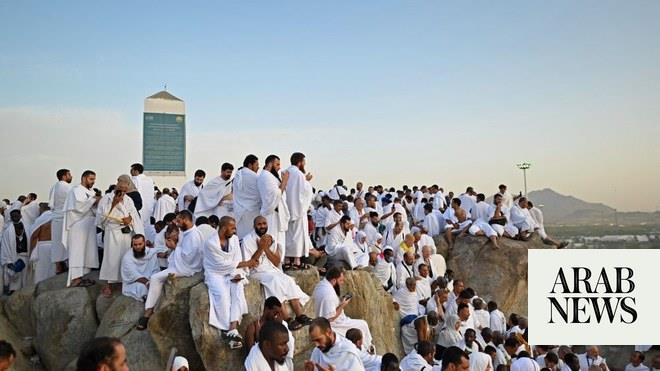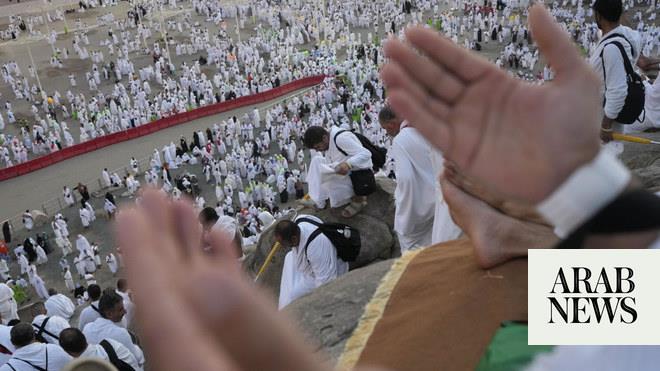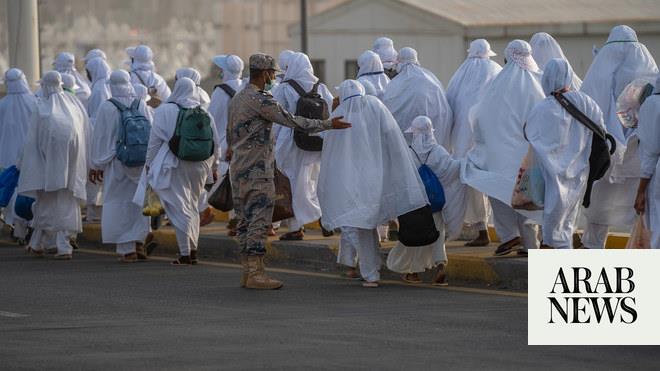
ARAFAT: More than 2 million pilgrims performing Hajj this year ascended Mount Arafat on Tuesday, the climax of a record-breaking pilgrimage returning to full capacity for the first time since the global pandemic.
As the sun rose, pilgrims camping in the tent city of Mina performed dawn (Fajr) prayers, then began reciting Qur’an verses and moving toward Arafat, where the Prophet Muhammad gave his final sermon 1,400 years ago.
The ritual is the high point of the annual pilgrimage, one of the five pillars of Islam, and a once-in-a-lifetime journey for those who are physically fit and financially able.
The 9th of Dhul-Hijjah, the Day of Arafat, is the single most important day of the Hajj. If a pilgrim misses this day, he or she misses the Hajj.
Announcing the ascent of Arafat — one of the world’s largest religious gatherings — the Ministry of Hajj and Umrah said that the tent city of Mina was empty of pilgrims by 10 a.m. on Tuesday.
Worshippers boarded almost 20,000 buses, while the Mashaer railway operated at full capacity transporting pilgrims via the holy sites.
“The pilgrims were transported easily and according to the schedule set,” the ministry said.
After worshippers performed the noon (Dhur) and afternoon (Asr) prayers on Arafat, they “dispersed to Muzdalifah smoothly, according to the plans set for them,” it added.
Pilgrims will return to Mina on Wednesday morning.
Elaborate arrangements were in place to safeguard pilgrims, with city police, civil defense, Saudi Scouts and other security agencies in action. Helicopters were used to monitor entry roads packed with worshippers.
Thousands of health workers were also on alert for cases of heatstroke and exhaustion as temperatures soared to 45 C.
Groups of worshippers holding umbrellas against the fierce sun and reciting verses from the Qur’an formed an endless queue on the rocky ascent to Mount Arafat, also known as the “Mount of Mercy.”
Speaking to Arab News, Mehmet Tokmak, a pilgrim from Germany, said: “This is one of the greatest experiences of my life. I am doing Hajj at a young age and am very happy to be here. The authorities are doing and excellent job.”
Mohammed Maarouf, originally from Syria but now living in Germany, said: “Thanks to the Almighty, I experienced a very good Hajj. It’s very well organized by the Saudi government. I am very excited as this is first time I am here to perform Hajj, though I have done Umrah many times.”
Yusifu Kargbo, from Sierra Leone, said: “This is an amazing Hajj. It’s hard to describe my feelings and emotions. I am living a great joy.”
Hatta Hussain, from Indonesia, said: “Saudi Arabia has made nice arrangements for Hajj — a very warm welcome for pilgrims on their arrival, and then good transport, health and security arrangements, which is praiseworthy.”
Nazim Hussain Jafri, from New Delhi, said: “A very good arrangement is in place to ensure a successful Hajj by King Salman and the Saudi authorities. I admire the warm hospitality extended to us during the pilgrimage. We were received very well in Jeddah on arrival, and throughout the stay I experienced very supportive environment.”
Pilgrims will spend the night out in the open in Muzdalifah, a valley between Mina and Mount Arafat. There they will collect pebbles to be used in a special ritual the following day.
After Fajr prayers on the 10th of Dhul Hijjah, pilgrims will leave Muzdalifah and head to Jamarat, where they will use the pebbles to stone a series of three pillars representing the devil.
Women and the elderly can delegate this responsibility to a male on their spiritual journey.
Men are then required to shave their heads, while women cut a lock of their hair as they do after Umrah.
Pilgrims are also required to sacrifice an animal and distribute the meat to the needy. Those who are unable to perform the sacrifice themselves can delegate the task.
Pilgrims then travel back to the Grand Mosque in Makkah.












